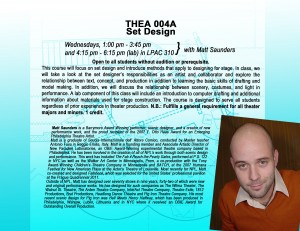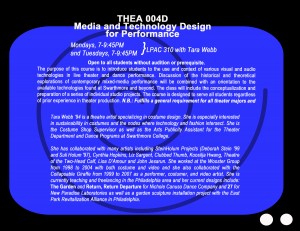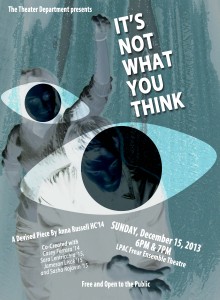by Sam Cleaves ’14
November 26, 2013
Swarthmore News and Information Office

Artist Dee Craig stands with his mural at the southeast end of the Science Center. (photo by Annette Newman)
David “Dee” Craig, a prolific mural artist from Northern Ireland, created a large mural that is now mounted on the southeast end of the College’s Science Center.
Craig’s work was facilitated by the Mellon Tri-College Creative Residencies Program. Supported by the Andrew W. Mellon Foundation, the program supports faculty of Swarthmore, Haverford, and Bryn Mawr Colleges from the natural sciences, social sciences, and humanities divisions to design and implement arts residencies in association with their curricular and scholarly agendas.
From Oct. 28 to Nov. 18, Craig painted and worked out of a purpose-built studio tent adjacent to the Science Center wall that his mural now covers. Painting first in the tent and then later directly on the wall, Craig’s mural took form before the eyes of students, staff, and faculty as they went about their work or walked to their classes. Craig also participated in two public conversations about mural art, conflict, and peacebuilding in Northern Ireland, first at Swarthmore’s McCabe Library to open an exhibit of his murals in Northern Ireland and again at Bryn Mawr, for an event sponsored by the Solomon Asch Center for the Study of Ethnopolitical Conflict.
Craig hails from East Belfast and is well known internationally in mural arts circles for his work, and his pieces have often been part of initiatives to replace paramilitary murals that became common during the 30 years of open conflict known as “The Troubles.” Such “reimaging” projects are part of the ongoing and sometimes halting transformation of conflict in Northern Ireland. A renowned artist, Craig was named one of the Belfast Media Group’s top-40 artists under 40 in 2008.
Dee Craig Mural Installation at Swarthmore College from Swarthmore Peace Studies on Vimeo.
Lee Smithey, associate professor of sociology and coordinator of the Peace and Conflict Studies Program, helped arrange Craig’s stay. Smithey’s initial application to the Creative Residencies Program noted that “the making of murals is shifting the symbolic landscape to incorporate new narratives within communities, re-articulating collective identities, and beginning to minimize the martial symbols that figured so prominently during thirty years of political conflict in Northern Ireland. Murals offer opportunities for regeneration in excluded or marginalized communities and sites for re-framing memory and identity.”
Smithey feels strongly that the core values of the program were successfully put into practice. “The College is fundamentally about empowering people through learning and sharing ideas,” he says, “and this residency has been very rich on both counts for many of us.”

Lee Smithey, associate professor of sociology and coordinator of the Peace and Conflict Studies Program (left) with Craig. (photo by Annette Newman)
The mural itself stands as testament to core global ambitions of the Swarthmore community. “We have tried to address the past, present, and future of the College,” Craig says, “and convey aspirations, hopes, and values that faculty, staff, and students expressed in planning discussions before I arrived.”
The goal was to erect a mural that expresses the College’s commitment to scholarly pursuits on behalf of the collective good, or what President Rebecca Chopp described in her inaugural address as “educat[ing] in a way that makes possible the setting aright and setting anew of the world.”
“It seems to me that Swarthmore is quite focused on learning in order to make a positive contribution in the world,” Craig says, “and I hope the mural expresses that.”
Throughout the month-long residency, Craig visited with seven classes across the three colleges. Students were also able to learn with him by collaborating on the project.
Kathryn Barron ’16, from Oak View, Calif., attended the initial lecture at McCabe and proceeded to sign up to paint. “I was amazed at how many people were contributing in various ways to the mural,” she says. “Painting was really fun, and I did learn a great deal about the process of putting up such a large work of art.”
Barron describes how, like the content of the image itself, the process of creating the piece united the community in the completion of a common goal. “I would say one of the greatest things I learned from Mr. Craig and the mural project was how art can be used to pull people together who normally wouldn’t necessarily cooperate on something creative,” she says. “You don’t hear about that kind of thing too often, that art is inherently collaborative.”
Craig had much to teach, but he doesn’t hesitate to concede that during his time at the College, he learned a great deal about Swarthmore and about his practice.
“Swarthmore feels like a very positive place,” he says. “It has been inspiring.” He elaborates that the local techniques for painting murals in Philadelphia are entirely new in Belfast. Paul Downie, executive director of the Community Arts Center in Wallingford, Pa., provided training and consultation on the process of painting on cloth panels that are subsequently adhered to a wall.
“It’s a new style of mural painting for us,” Craig says. “In this piece, I have fused this new format with traditional mural painting. I look forward to taking this process back and introducing it to Northern Ireland mural culture in ways that can help promote cross-community cohesion.”
Craig’s residency was truly an exchange. Just as Craig shared his unique experience and talent with Swarthmore, the College was able to offer him training in a new mural painting technique. Perhaps most importantly, new relationships and networks have been established that will support peacebuilding and creative arts both in the U.S. and in Northern Ireland.



 Still figuring out your schedule for the Spring? Sign up for Set Design with Matt Saunders: the course will focus on set design and introduce methods that apply to designing for stage. In class, we will take a look at the set designer’s responsibilities as an artist and collaborator and explore the relationship between text, concept, and production in addition to learning the basic skills of drafting and model making. In addition, we will discuss the relationship between scenery, costumes, and light in performance. A lab component of this class will include an introduction to computer drafting and additional information about materials used for stage construction. The course is designed to serve all students regardless of prior experience in theater production.
Still figuring out your schedule for the Spring? Sign up for Set Design with Matt Saunders: the course will focus on set design and introduce methods that apply to designing for stage. In class, we will take a look at the set designer’s responsibilities as an artist and collaborator and explore the relationship between text, concept, and production in addition to learning the basic skills of drafting and model making. In addition, we will discuss the relationship between scenery, costumes, and light in performance. A lab component of this class will include an introduction to computer drafting and additional information about materials used for stage construction. The course is designed to serve all students regardless of prior experience in theater production.
 The Department of Theater and the Advanced Directing Workshop (THEA 055)
The Department of Theater and the Advanced Directing Workshop (THEA 055)

